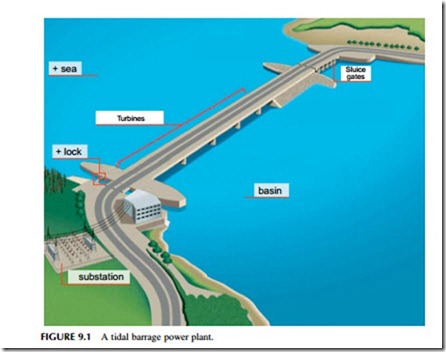The tidal rise and fall of the seawater level along a coastline leads to the movement of large volumes of water in and out of coastal inlets and estuaries. This moving water can be used in the same way as the water flowing down a river as a means of generating electrical power.
The simplest way of exploiting the energy available is to build a tidal bar- rage across the mouth of an estuary or suitable inlet. The tidal changes in sea level will then cause water to flow cyclically backwards and forwards across this barrage. When the tide rises, water flows from the sea into the estuary or inlet, passing through sluice gates in the barrage. At high tide the sluice gates are closed, and when the tide ebbs, the water behind the barrage is allowed to flow back to the sea through hydraulic turbines, generating power in the process (Figure 9.1).
The head height available for generation will vary with the state of the tide and a tidal plant will normally not start generating until sometime after high tide to obtain the optimum head for the site. In principle, it is possible to generate when the tide is rising instead of when it is falling. Usually, however, ebb-tide generation alone is preferred.
Exploitation of tidal motion has a long history and tidal mills with water wheels have been known for the best part of a millennium in Europe and else- where. The earliest record is from 900 AD, but there will probably have been much earlier mills in operation. These early mills would impound water during the incoming tide, allowing the mill to operate for about three hours on each tide.
Today’s tidal power plants for electricity generation are relatively modern and also rare. Apart from some small plants built in China from the late 1950s onwards, the first commercial plant was built in France where it started oper- ating in 1966. This remains one of the two largest operating tidal power plants and one of only a handful of commercial plants worldwide. The reason why there are so few plants is primarily down to the high cost of building a tidal barrage, the expense of which makes barrage tidal power plants appear uneconomical. There are also a limited number or sites where tidal plants of this type can be constructed, again limiting the potential. Nevertheless, the tidal power plant remains of interest because of its long life and reliability.
In addition to the coastal ebb and flow of the tide that is exploited by barrage plants, tidal movement generates coastal currents, which offer another route to exploiting the energy, using tidal current devices that are much like underwater wind turbines. These devices, which have a range of applications, are discussed in Chapter 14 on marine technologies.
